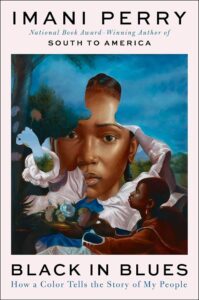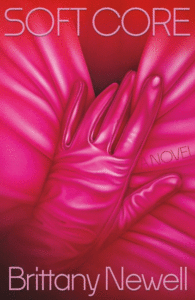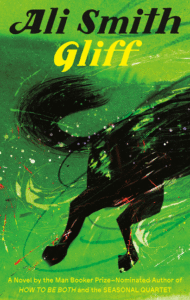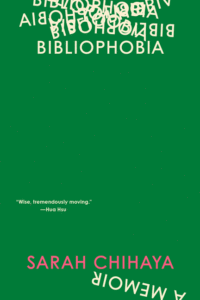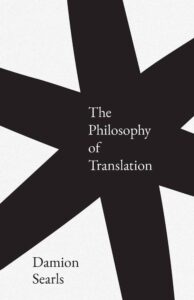
5 Book Reviews You Need to Read This Week
“It reads as if it is trying to wrap its arms around the abundance of experience.”
Our feat of fabulous reviews this week includes Mychal Denzel Smith on Imani Perry’s Black in Blues, Sophie Haigney on Brittany Newell’s Soft Core, Hamilton Cain on Ali Smith’s Gliff, Briallen Hopper on Sarah Chihaya’ Bibliophobia, and Lily Meyer on Damion Searls’ The Philosophy of Translation.
Brought to you by Book Marks, Lit Hub’s home for book reviews.
*
“Perry’s idea, as the title suggests, is that there is such a rich connection between Black people and ‘blue’ that it’s possible to look across time at various pieces of art and artifacts, literal and metaphorical blues, and come away with a narrative of Black people, one that points back to Rafaz’s question—’What did I do to be so black and blue?’
The beats of Perry’s story are not unfamiliar; Black in Blues does not position itself as revisionist. What’s compelling, when and where Perry peers inside of the familiar, through her black and blue lens, to provide us new ways of looking at it, is that the two concepts have become inseparable.
…
“Perry asks us to see Black people’s relationship to the color blue in its spiritual and material specialness, and though blue carries immense tragedy inside of it, neither black nor blue is wholly defined by the cruelty that links them. Like a blues song, the beauty is found when you tune into its complex frequencies on the backbeat.
…
“Left unexplored in Black in Blues is the question: Why blue? Other colors make appearances—red, green, yellow—and all could likely serve as the literary anchor; Black life is colorful. The connection to blue is undeniable, as Perry shows time and again, but in a way taken for granted. Early on she recalls asking an elder in Little Rock, Arkansas, why she painted her house a bright blue. ‘That’s the color it was,’ was the reply. And that’s that.”
–Mychal Denzel Smith on Imani Perry’s Black in Blues (The New Republic)
“Soft Core is pacey and rich, full of verve, drama and detail. Newell, the author of one other novel, Oola, also works as a professional dominatrix. She has a talent for drawing out the particulars of varied worlds. So many contemporary novels feel almost uninhabited, as though they are taking place in the space of pure consciousness; narrators seem to be wandering down empty hallways staring at their phones.
This novel—despite being narrated in first person by a woman who is often quite alone, alone at the point of near-breakdown, alone in moments of ecstasy—is not like that at all. Through Ruth’s eyes we see San Francisco in three dimensions—what lies behind the pink neon strip club signs, of course, but also the specific draftiness of tall Victorian houses and the oppressive silence of richer neighborhoods at night.
There are things in this book, full-fledged objects! There is sexuality, but also highly specific sensuality: sounds, tastes, smells…In this way, Soft Core is ambitious; it reads as if it is trying to wrap its arms around the abundance of experience, which is often, as we say now, ‘too much.’
…
“Does Soft Core come together? Sort of. The final third is rougher than the opening. Subplots peter out or climax abruptly. But the last pages offer a different and more satisfying kind of crescendo—open-ended, strange, joyfully loose. On the verge of leaving one phase of her life and entering another, Ruth thinks about the web of people who have been flitting in and out of her world, and certain mysteries do seem solved.”
–Sophie Haigney on Brittany Newell’s Soft Core (The New York Times Book Review)
“We live in a time of prophets. The planet’s richest man has vowed to colonize Mars. Chatbots and AI portend job losses. And for bibliophiles, dystopian fiction explores the grim near-future…Ali Smith, one of our greatest literary authors, now offers a tricksy masterwork that straddles formal lines while reimagining Aldous Huxley’s 1932 novel, Brave New World, published as fascism ascended across Europe. Smith peers into the mists ahead, trying to make sense of forces gathered against us. The culprits are many—oligarchs, corporations, politicians, social media—as well as normie citizens willing to sell out their neighbors. There’s also a horse whose mystical aura may save the day.
…
“Smith has always worn her lefty politics on her sleeve. Gliff’s language is sparer than in her famous Quartet, yet she’s still throwing everything—art, literature, social justice, tart humor—against atrocities that damage our moral compasses and cripple our lives. We may be anesthetized to horrors such as ethnic cleansing, but not Smith, no way, no how. A polemical tone punches through the varnish of her prose, a rage that even art can’t soothe. ‘One person here had been unverified for saying out loud that a war was a war when it wasn’t permitted to call it a war. Another had found herself declared unverifiable for writing online that the killing of many people by another people was a genocide,’ Smith writes. ‘Another had been unverified for speaking at a protest about people’s right to protest.’ This expressionist technique reveals a rawness beneath the book’s surface, an immediacy, like Helen Frankenthaler or Jean-Michel Basquiat exposing unprimed canvas in their paintings.”
–Hamilton Cain on Ali Smith’s Gliff (The Washington Post)
“Although Bibliophobia is, among other things, a tale of muted despair, it crackles with the electrical charge of a broken taboo. Quiet as it’s kept—at least in modern-day literary circles—reading is a perilous practice. Though it can obviously be pleasurable, it can also be unpleasant, compulsive, destabilizing, or overwhelming. Our metaphors for reading hint at this: There is something implicitly troubling about being addicted to reading, about ‘losing yourself’ in a book, or even being ‘unable to put it down,’ like the victim of a paralyzing curse. Chihaya not only names these dangers—she re-creates them for us, evoking the way reading can mirror the soft undertow of an opiate or the lethal sharpness of a razor’s edge.
…
“At one point, she writes about her childhood fascination with legendary ice-skater Kristi Yamaguchi, but the athlete I kept thinking about as I read was Simone Biles, who famously got ‘the twisties’ at the 2020 Olympics. What happens when the thing you’re best at, which is incidentally the thing that pays the bills, is something you can no longer safely do—something you are worried might kill you if you keep trying?
…
“Bibliophobia broadens, deepens, and disturbs our sense of reading’s risks. For Chihaya, the danger does not lie in the content of books but in her way of relating to them; not in identification with a particular character, but in her vulnerability to the violence of reading itself.
…
“Ultimately, Bibliophobia is a book of paradoxes. It’s a profoundly satisfying book about the maddening inadequacy of books. A fluidly written story about devastating writer’s block. An anti-narrative narrative with a classically pleasing structure of rising action, crisis point, denouement that would look beautiful sketched on a chalkboard.”
–Briallen Hopper on Sarah Chihaya’ Bibliophobia (The New Republic)
“What differentiates translation from the other literary arts, he argues, is the way translators read. The Philosophy of Translation is a meditation on what it means to read like a translator, which means, really, that it’s an ode to close reading. Searls writes in his introduction that, rather than adopting the imperious stance of theory—a discipline that too often ‘suggest[s] the foolishness or impossibility of trying to engage in the practice’ without it—he hopes that practicing translators will ‘find these ideas suggestive, illuminating, or at least lovely.’ As a practicing translator myself, I certainly did, and yet what I most enjoyed about The Philosophy of Translation was something more implicit in its mission. Without claiming that he set out to do so, Searls has written a philosophy of what, how, and why to read.
…
“While not dismissing out of hand the capacity that language has to shape cognition, he feels, fundamentally, that we aren’t as different from each other as the German Romantic vision of language would suggest, and we certainly shouldn’t read or translate as if we were. Searls’s theory is that reading as a translator means rejecting the idea of foreignness wherever and however we can. This is a major realignment of how we see translation and its practitioners.
…
“For Searls, the way to tell bad writing from good is this: ‘Bad writing is predictable, good writing is defamiliarizing.’ Put differently, a good book either feels unfamiliar or makes us feel less familiar to ourselves. In reading it, we can remember that this unsettling sensation—this sensation of foreignness—is, in fact, not foreign at all. It’s human; it’s an expansion of the mind and the heart. A good piece of writing, if and only if it’s read well, can do that to us. In The Philosophy of Translation, Searls shows that reading as a translator, or reading like a translator, is a method of reading very, very well.”
–Lily Meyer on Damion Searls’ The Philosophy of Translation (The Nation)
Book Marks
Visit Book Marks, Lit Hub's home for book reviews, at https://bookmarks.reviews/ or on social media at @bookmarksreads.










